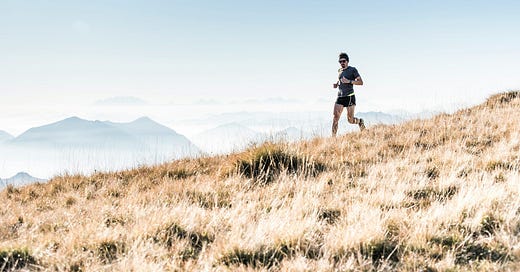Become a Member of Two Percent
Become a Member of Two Percent to get full-access to all of our life-enhancing stories and podcasts.
Our promise to you: We’ll save you more time and money than the monthly cost.
The Post
Two weeks ago, we covered the science of whether you can out-exercise a subpar diet.
The answer is yes—but there are two catches.
Catch number one: it takes a lot of exercise.
Catch number two: You’ll have to maintain high exercise levels as long as you eat that subpar diet. If you lower your exercise levels, you’ll have to adapt your diet or you’ll gain weight.
With that in mind, today we’re exploring whether there’s an ideal weekly rucking or running distance.
What’s a manageable amount of cardio we should get each week to maintain our health, desired weight, and a lifelong level of fitness?
Think of it as a weekly cardio prescription for anyone.
To answer the question, I’m publishing unreleased material I discovered while reporting The Comfort Crisis.
Let’s roll …
The role of endurance in human evolution
In short
The human body is uniquely adapted for endurance exercise.
The details
While reporting The Comfort Crisis, I traveled to Harvard University. This was 2019. I was there to speak with Daniel Lieberman.
Lieberman studies the evolution of the human body and why we’re built the way we are, especially as it relates to human movement and physicality. He’s the guy who discovered just how important running is for humans.
Humans aren’t fast compared to other animals. Many other mammals can beat us in a sprint. Because of this, anthropologists since the discipline’s inception considered running something of a useless parlor trick.
But Lieberman found that, no, we can’t go fast. But we can go far—especially in hot weather.
Most other mammals can’t do this. On a hot day, a relatively fit human will beat most other mammals in a distance race. Lions, tigers, bears, dogs, etc.
(Want to go deeper? Read Lieberman’s groundbreaking study.)
Humans are born to run—and carry
In short
Cardio exercise is likely more important for us than raw strength. Carrying weight is our most impressive strength act—and it also works our cardiovascular system.
The details
Humans can run far in the heat, Lieberman’s Nature paper nicknamed “Born to Run” explains, thanks to a handful of adaptations we developed over millions of years.
We stand on two legs, have springy arches in our feet, long tendons in our legs, big butt muscles, sweat glands across our body, no fur, complicated noses that humidify air before it hits our lungs, etc.
Other mammals gallop quickly for a few minutes, then must stop and pant to release heat and cool down.
Endurance was our killer app, and we used it to kill. We practiced what’s called persistence hunting: slowly but surely tracking and chasing down prey for miles upon miles until the animal toppled over from heat exhaustion. Then we’d spear or club it and have dinner.
Because humans have undergone intense evolutionary selection for endurance and aerobic activity, Lieberman believes cardio exercise is more important for us than raw strength.
If you read The Comfort Crisis, you know that I agree with him—with a caveat.
I believe carrying was equally if not more important to us than running.
After we’d speared that animal, we’d have to carry it back to camp. That’s where our strength shined. It wasn’t raw strength. We’d have to engage relatively low levels of total body strength as we covered miles of rough ground.
And that’s just one example of our carrying. We’d carry all day when we gathered food. And there’s also some fascinating science around the benefits of carrying children. Read more on that here.
We’re the only mammals who can carry for distance. And it shaped us. Humans are, in fact, “extreme” in their ability to move items from point A to B, wrote researchers in a study in PLOS One.
Lieberman’s great insight
In short
While I was at Harvard, Lieberman told me something that forever changed how I view exercise.
The details
I spent the better part of an afternoon at Harvard. Lieberman and I chatted in his office, and he showed me his laboratory (which includes all sorts of incredible, laboratory-grade treadmills!).
We talked about how physical activity keeps humans healthy, and how the way we now approach exercise is rather strange in the grand scheme of things.
For example, we both agreed that people in the gym community over-hype the benefits of strength training compared to cardio. Meanwhile, people in the running community over-hype the benefits of cardio compared to strength. “It’s kind of a Rorschach test,” he told me.
Which, naturally, led me to ask him what exercise he does.
He told me he prefers running. He’s run the Boston Marathon more than once.
But he also tries to lift in the gym a couple of times a week. He’s especially realizing the value of strength training as he ages.
Then he said something I haven’t forgotten. It’s shaped how I think about my own exercise routine.




